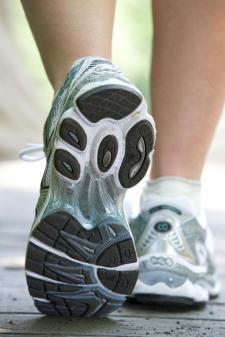12 Week Walking Program for Weight Loss

Feeling sluggish and unmotivated to exercise? Can’t stand the thought of huffing and puffing your way through a strenuous exercise routine?
While getting your heart rate up is an important part of an exercise program, jumping in and going all out is the wrong way to go about things. If you’re new to exercise or are more than 20lbs overweight — or if you have an aversion to *shudder* the big E — one of the best ways to ease yourself into exercise is to start a walking program. Studies show that people are more likely to stick to a walking program.
See? I’m always trying to set you up for success!
Let me, um, ‘walk’ you through an easy-to-follow 12 week walking schedule that will having you walking away those extra pounds — and may even get you to like exercising. (Hey, it can happen!) I’ll even tell you one simple tip on how to walk faster. Bet you didn’t know this one…
Before we get to the walking program, let’s go over a few walking basics. I know! Sounds odd to say it. You know how to walk, right? But when you’re walking for exercise, you want to start off on the right foot. (Not literally. You can start on the left foot, if you prefer.)
(As with all exercise, be sure to consult a doctor first if you have any questions.)
How to Walk Properly
Wear the proper footwear. A good pair of comfortable running shoes will be enough to get you started. They don’t need to be expensive as long as they support your feey and don’t give you blisters. If you eventually move to more hilly terrain, you can invest in a pair of hiking shoes.
Walk it proud. Keep your chest up and your shoulders back. No slouching when it comes to walking! Keep your head looking about 10 feet straight ahead of you.
Warm it up, stretch it out – and cool it down and stretch it out again. Warm up by walking slowly for at least five minutes. After warming up, do some light stretching of your calves and lower back. When you’re done walking, cool down by walking slowly for at least five minutes and then do some more stretching, adding in stretches for the quads and hamstrings (front and back of the upper legs).
How to Walk Faster
Not a lot of people know this: the key to walking faster is not to take longer strides, but to take short, quick strides. Try it the next time you’re out walking and are ready to add a bit more intensity.
How Many Calories Will You Burn Walking?
It all depends on how much you weigh and how fast you walk. But when it comes to this walking program, the key is to gradually work your way up from no walking (or very little walking) to walking for weight loss on a regular basis.
If you’re curious, you can use my Calories Burned calculator to estimate the amount of calories you’ll burn while walking:
- Calories burned walking 2 mph
- Calories burned walking 2.5 mph
- Calories burned walking 3.0 mph
- More walking speeds
How Fast Should I Walk? And How Can I Increase My Intensity?
You need to start off with a pace that’s comfortable for you. If you’re not used to exercising, you could start off at 2mph or lower. Start walking on a flat terrain. Once you’re a few weeks into the walking program, you can increase the intensity by slowing adding hilly terrain and/or increasing your walking speed.
It’s a delicate balance: you want to increase the intensity of the walk without injuring yourself or overdoing it. Focus on duration at first. If you can walk, say, 15 minutes at a certain pace comfortably, you’re ready to walk a bit faster for the same 15 minutes.
The walking program down below focuses on three different ways measure intensity.
1) Maximal Heart Rate (MHR)
The formula formula to calculate your maximal heart rate is:
220 – age = Maximal Heart Rate (MHR)
That formula is just an estimate. If you’re older, it may calculate a maximal heart rate that’s too high. It will do in a pinch but since it produces an average heart rate, you may need to increase or decrease your effort depending on your how you’re feeling. You can use MHR in combination with RPE (see #3).
If you use this formula, you’ll need to use the MHR percentages in the table down below.
2) Heart Rate Reserve (HRR)
Another way to calculate your heart rate is using FitWatch’s Target Heart Rate calculator. It uses a different formula (Karvonen) to calculate your working heart rate, but you need to know your Resting Heart Rate. If you use this formula to calculate your Heart Rate Reserve (HRR), you’ll need to use the HRR percentages in the table down below.
| RPE | Exertion |
| 0 | Nothing at all |
| 0.3 | |
| 0.5 | Extremely weak |
| 0.7 | |
| 1 | Very Weak |
| 1.5 | |
| 2 | Weak |
| 2.5 | |
| 3 | Moderate |
| 4 | |
| 5 | Strong |
| 6 | |
| 7 | Very Strong |
| 8 | |
| 9 | |
| 10 | Extremely Strong |
| 11 | |
| ++ | Absolute maximum |
| © Gunnar Borg, 1982, 1998 | |
3) Rate of Perceived Exertion
The simplest way to track your intensity is to use the Rate of Perceived Exertion (RPE) scale. An RPE of 2 on the 1 through 10 scale is like walking through the grocery store, while a 7 on the RPE scale is more of a hike through hilly terrain, where your heart is pounding and you’re breathing fast.
Always listen to your body (and your doctor). Don’t go beyond what feels comfortable to you just because a calculator or heart rate monitor says you should be working at a certain intensity.
Tracking Your Walks
Dust off the old pedometer and keep track of the steps you take while walking. Roughly speaking, 2000 steps is about a mile.
Did you know you can track your walks in the FitWatch Fitness Tracker? You can even track the miles you walked, the amount of steps you took and your average heart rate. Click here to sign up for your free tracker account.
The goal of this walking program is to bring you from the lower end of recommended cardio guidelines to right around the middle of the guidelines. The first four to six weeks are what’s called the initial conditioning phase. Weeks 5 through 12 are what’s called the improvement conditioning phase.
If you find that the first week is too easy, slightly increase the duration and/or intensity. If you find it too difficult, decrease the duration and intensity to a comfortable level. The goal is to ease your way into exercising on a regular basis.
If at any time you feel the need to repeat a week, feel free to do so.
So, with all the above in mind, here’s the FitWatch 12 Week Walking Program.
Frequency = the amount of times to walk per week
Intensity = % of MHR / % of HRR / RPE
Minutes = Suggested Time spent walking in minutes
Warm Up/Cool Down = Suggested Time spent warming up and cooling down. Don’t forget to stretch, too!
| Week | Frequency | Intensity | Warm Up | Minutes | Cool Down |
| 1 | 2 – 3 | 55% MHR 40%HRR 2 – 3 RPE |
5 | 10 | 5 |
| 2 | 2 – 3 | 55% MHR 40%HRR 2 – 3 RPE |
5 | 10 | 5 |
| 3 | 3 | 60% MHR 45%HRR 2 – 3 RPE |
5 | 15 | 5 |
| 4 | 3 | 60% MHR 45%HRR 3 – 4 RPE |
5 | 15 | 5 |
| 5 | 3 – 4 | 60-65 MHR 50%HRR 3 – 4 RPE |
5 | 20 | 5 |
| 6 | 3 – 4 | 60-65% MHR 50%HRR 3 – 4 RPE |
5 | 20 | 5 |
| 7 | 3 -4 | 65-70% MHR 55%HRR 4 – 5 RPE |
5 | 25 | 5 |
| 8 | 3 – 4 | 65-70% MHR 55%HRR 4 – 5 RPE |
5 | 25 | 5 |
| 9 | 4 | 65-70% MHR 60%HRR 5 RPE |
5 | 30 | 5 |
| 10 | 4 | 65-70% MHR 60%HRR 5 – 6 RPE |
5 | 30 | 5 |
| 11 | 4 | 70-75% MHR 65%HRR 6 RPE |
5 | 35 | 5 |
| 12 | 4 | 70-75% MHR 65%HRR 6 RPE |
5 | 35 | 5 |
Must Read
5 Reasons to Start Walking
5 Ways to Burn More Calories Walking
Indoor Walking: Don’t Let the Cold Slow You Down
